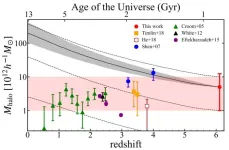At the center of every galaxy is a supermassive black hole. Beyond a certain size, these become active, emitting huge amounts of radiation, and are then called quasars. It is thought these are activated by the presence of massive dark matter halos (DMH) surrounding the galaxy, directing matter towards the center, feeding the black hole. A team including researchers from the University of Tokyo have, for the first time, surveyed hundreds of ancient quasars and found this behavior is very consistent throughout history. This is surprising, as many large-scale processes show variation throughout the life of the universe, so the mechanism of quasar activation could have implications for the evolution of the entire universe.
Measuring the mass of DMHs is not easy; it’s famously a very elusive substance, if substance is even the right word to use, given the actual nature of dark matter is unknown. We only know it exists at all due to its gravitational impact on large structures such as galaxies. Thus, dark matter can only be measured by making observations about its gravitational effects on things. This includes the way it might pull on something or affect its movement, or through the lensing (bending of light) of objects behind a suspected area of dark matter.
The challenge becomes greater at large distances, given how weak the light from more distant, and therefore ancient, phenomena can be. But this did not stop Professor Nobunari Kashikawa from the Department of Astronomy, and his team, from trying to answer a long-standing question in astronomy: How are black holes born, and how do they grow? The researchers are especially keen to explore this in relation to supermassive black holes, the largest kind, which exist in the heart of every galaxy. These would be very difficult to study were it not for the fact that some grow so massive they begin to output incredibly powerful jets of matter or spheres of radiation that in either case become what we call quasars. These are so powerful that even at large distances, we can now observe them using modern techniques.
“We measured for the first time the typical mass for dark matter halos surrounding an active black hole in the universe about 13 billion years ago,” said Kashikawa. “We find the DMH mass of quasars is pretty constant at about 10 trillion times the mass of our sun. Such measurements have been made for more recent DMH around quasars, and those measurements are strikingly similar to what we see for more ancient quasars. This is interesting because it suggests there is a characteristic DMH mass which seems to activate a quasar, regardless of whether it happened billions of years ago or right now.”
Quasars at great distances appear faint, as the light which left them long ago has spread out, was absorbed by intervening matter, and has been stretched into nearly invisible infrared wavelengths due to the universe expanding over time. So Kashikawa and his team, whose project began in 2016, used multiple surveys of the sky which incorporated a range of different instruments, the main one being Japan’s Subaru Telescope, located in U.S. state of Hawaii.
“Upgrades allowed Subaru to see farther than ever, but we can learn more by expanding observation projects internationally,” said Kashikawa. “The U.S.-based Vera C. Rubin Observatory and even the space-based Euclid satellite, launched by the EU this year, will scan a larger area of the sky and find more DMH around quasars. We can build a more complete picture of the relationship between galaxies and supermassive black holes. That might help inform our theories about how black holes form and grow.”
###
Journal article: Junya Arita, Nobunari Kashikawa, Yoshiki Matsuoka, Wanqiu He, Kei Ito, Yongming Liang, Rikako Ishimoto, Takehiro Yoshioka, Yoshihiro Takeda, Kazushi Iwasawa, Masafusa Onoue, Yoshiki Toba and Masatoshi Imanishi. “Subaru High-z Exploration of Low-Luminosity Quasars (SHELLQs). XVIII. The Dark Matter Halo Mass of Quasars at z ∼ 6”, The Astrophysical Journal, DOI: 10.3847/1538-4357/ace43a
Funding:
J.A. is supported by the International Graduate Program for Excellence in Earth-Space Science (IGPEES). N.K. was supported by the Japan Society for the Promotion of Science through Grant-in-Aid for Scientific Research 21H04490. Y.M. was supported by the Japan Society for the Promotion of Science KAKENHI grant No. JP17H04830 and No. 21H04494. K.I. acknowledges support by grant PID2019-105510GB-C33 funded by MCIN/AEI/10.13039/501100011033 and “Unit of excellence Mar´ıa de Maeztu 2020-2023” awarded to ICCUB (CEX2019-000918-M). M.O. is supported by the National Natural Science Foundation of China (12150410307).
Useful links:
Graduate School of Science - https://www.s.u-tokyo.ac.jp/en/
Department of Astronomy - http://www.astron.s.u-tokyo.ac.jp/en/
Research Center for the Early Universe - https://www.resceu.s.u-tokyo.ac.jp/top_en.php
Research contact:
Professor Nobunari Kashikawa
Department of Astronomy, The University of Tokyo,
7-3-1 Hongo, Bunkyo-ku, Tokyo, 113-0033, Japan
n.kashikawa@astron.s.u-tokyo.ac.jp
Press contact:
Mr. Rohan Mehra
Public Relations Group, The University of Tokyo,
7-3-1 Hongo, Bunkyo-ku, Tokyo, 113-8656, Japan
press-releases.adm@gs.mail.u-tokyo.ac.jp
About The University of Tokyo
The University of Tokyo is Japan's leading university and one of the world's top research universities. The vast research output of some 6,000 researchers is published in the world's top journals across the arts and sciences. Our vibrant student body of around 15,000 undergraduate and 15,000 graduate students includes over 4,000 international students. Find out more at www.u-tokyo.ac.jp/en/ or follow us on Twitter at @UTokyo_News_en.
END





